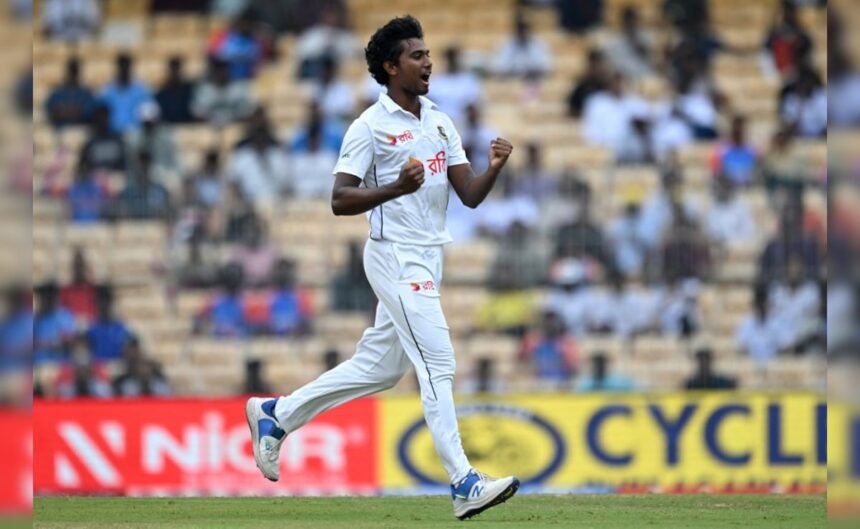[ad_1]
For the last one month, Bangladesh is on a mission to reverse a long-standing trend of left-arm spinners leading their bowling. Two beanpole quicks are at the forefront of that changing of baton – Hasan Mahmud and Nahid Rana. They arrived on these shores after a sensational effort against Pakistan, but India could be a daunting destination even for the more experienced ones. But on the opening day of the first Test against India here on Thursday, Mahmud (4/58) and Rana (1/80) justified the hype around them, rather contrastingly.
Mahmud owns lively pace but banks more on an exemplary seam position and other variations to make an impact, whereas Rana is the battering ram, looking to unsettle the batters with raw pace.
It was evident in their respective approach at Chepauk.
But Mahmud was more successful this day, taking four wickets – Virat Kohli, Rohit Sharma, Shubman Gill and Rishabh Pant – a list that still remains a dream even for the more reputed names.
Rana hustled Indians occasionally. He hurried Yashasvi Jaiswal with a 148 kmph corker, forcing the opener to edge it to the cordon.
But this silent revolution in Bangladesh cricket is more carefully planned than organic.
“Look at Nahid and Mahmud, we were trying to find some genuine fast bowlers for sometime now. I am not belittling spinners, who have done great work for our country.
“But if you need to be a successful cricketing nation across the world, you need world-class fast bowlers, like when we go to England or Australia,” Alamgir Kabir, a former Bangladesh pacer who is a mentor to both Mahmud and Rana, told PTI.
Kabir underlined the role of a robust grassroot level system in Bangladesh in this new rush of quality pacers.
“I will not call it perfect or anything, but we have a strong grassroot system where coaches and talent spotters are committed to what they do. There are a lot of talented kids around Bangladesh playing tape-ball and tennis ball cricket, who need the right kind of encouragement at the right time.
“Take the case of Nahid, he is coming from tape ball cricket. I found him and took to my academy and give training. It’s like polishing a diamond,” said Kabir, who is now a coach at the Clemons Cricket Academy in Dhaka.
But Sridharan Sriram, the former India batter who coached Bangladesh in the past, had a word of caution for the tyros.
“They are talented for sure, and are doing well at present. But the challenge for them is to sustain this journey and grow into the role. It is not easy. Hopefully, there will be right advice and support for them,” Sriram told PTI.
Sriram was impressed by Mahmud’s outing as well.
“Four wickets…yeah, he did well. He showed good acumen to exploit the favourable conditions in the morning. I haven’t worked with them a lot, but this Bangladesh team looks a good mixture of youth and experience. Hopefully, the young cricketers will remain on course,” said Sriram.
Kabir has little doubt about the focus of these young players.
“They are all very motivated. Recently, there was some unrest in the country and these kids were playing cricket in Pakistan.
“Obviously, they were concerned, but showed good maturity to focus on cricket once they entered the field and after the match they will call and ask for updates (about the turbulence). The result is there for all to see -a 2-0 win over Pakistan,” he added.
Bangladesh pacers have also been fortunate to have come under the tutelage of South African great Allan Donald and former West Indian pacer Otis Gibson.
They opened a whole new perspective about bowling, particularly about pace bowling, to upcoming Bangladesh bowlers.
“Look, I think Mashrafe (Mortaza) was the first pacer of some reputation to come from Bangladesh then Taskin (Ahmed) followed. But now, we have a good bunch – Shoriful Islam, Ebadot Hossain etc, who will take our bowling forward,” said Kabir.
But the rise of these new crop of pacers is gradually changing the image around Bangladesh bowling unit.
Head coach Chandika Hathurusingha explained it.
“The point of difference is the fear factor. When a bowler comes up to 150 kph, it is human nature (to get afraid).
“We have a certain reaction time. So, it challenges your reaction time and decision making. You can bring that fear factor into the opposition,” said Hathurusingha.
The wheels of change have been set in motion and Bangladesh needs to ensure that it keeps rolling.
(Except for the headline, this story has not been edited by NDTV staff and is published from a syndicated feed.)
Topics mentioned in this article
[ad_2]
Source link




